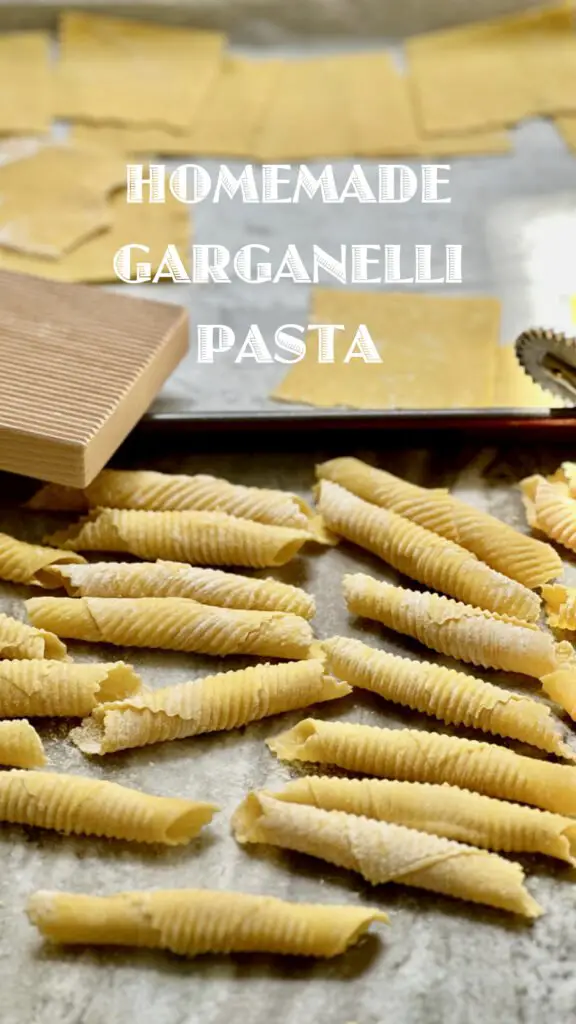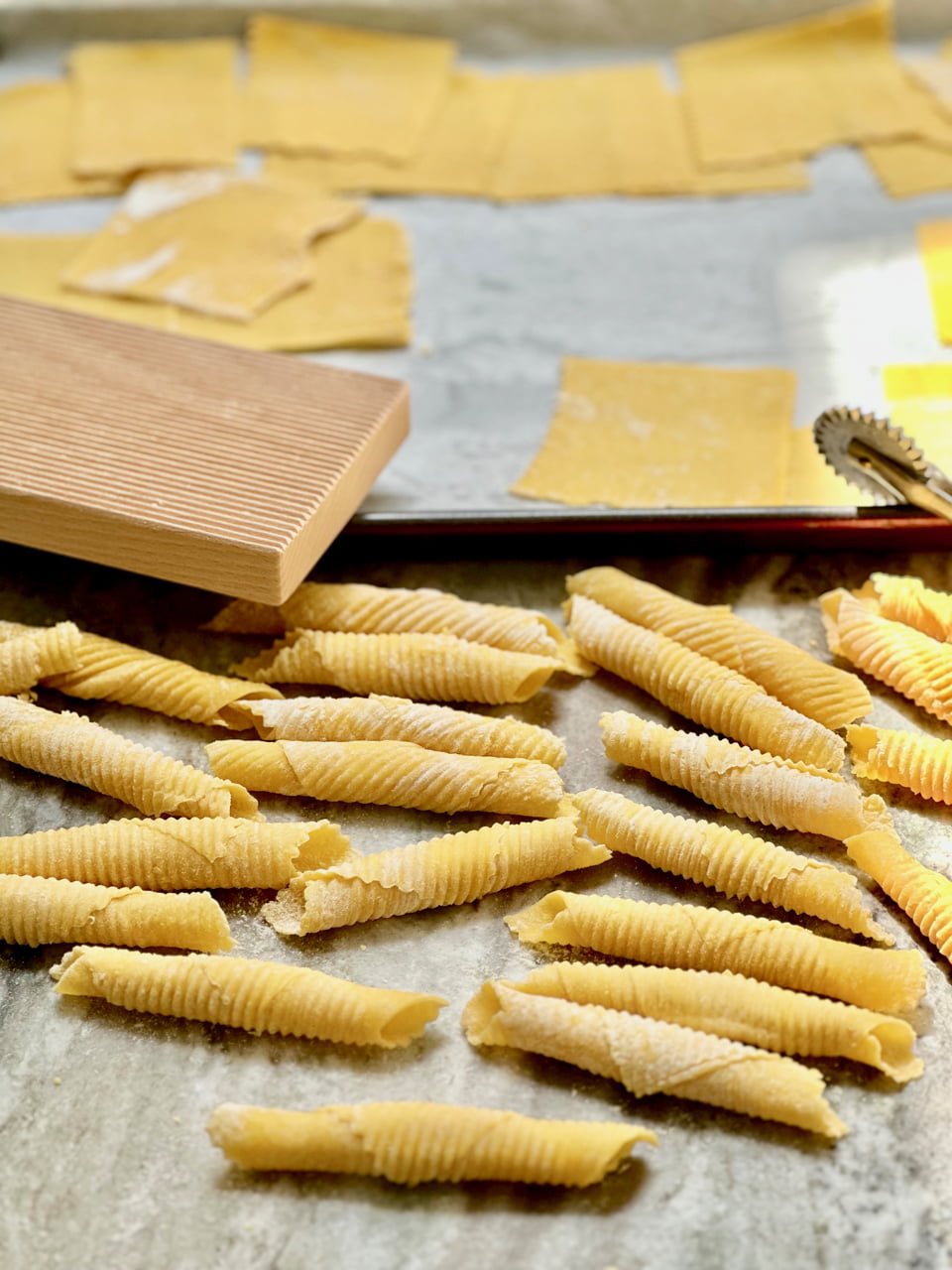Homemade Garganelli Pasta, with only 3-ingredients – flour, eggs, salt – is the best pasta, whether you use a Garganelli board to shape it, or simply cut into spaghetti strips!

Let’s Talk About Homemade Garganelli!
Garganelli is one of those pastas that’s as charming to make as it is to eat. It’s fun, hands-on, and feels like a tiny celebration of Italian tradition right at your kitchen counter.
With just three simple ingredients, flour, eggs, and a pinch of salt, you can create a dough that’s tender, golden, and full of rich flavor. Once rolled out, the real joy begins: using a small ridged board and a thin dowel (or even the handle of a wooden spoon), you roll each square of dough diagonally to form those beautiful quill-like tubes.
The ridges aren’t just decorative, they help sauces cling perfectly, whether you’re tossing them in a silky cream sauce or a bright tomato one.
What Makes Garganelli Special
What makes Garganelli extra special is its rustic look, each piece slightly different, proof that it was made by hand with care.
And unlike extruded pastas from a box, homemade Garganelli has that tender bite and rich eggy flavor that only fresh pasta can offer, fresh pasta that you made!
Homemade Garganelli Pasta – Fun To Shape, Easy To Love
There’s something so satisfying about making pasta from scratch, especially when it’s as fun and hands-on as Garganelli. This traditional Italian pasta looks fancy, but it couldn’t be easier to make.
As you roll each square of dough diagonally across the ridges, the pasta curls into its signature quill shape, rustic, beautiful, and delightfully satisfying. The best part? No two pieces look exactly alike, and that’s the magic of homemade pasta.
Making Homemade Pasta
I never realized that making handmade pasta was so easy. Why have I been buying flour/water pasta all these years, when I could have enjoyed a rich egg/flour pasta!
Homemade Egg Pasta is simply egg and flour and rather easy to make, yet the flavor of something rich and time consuming, yet it comes together so easily I’ve taught my grandchildren to make it!
With the help of a rolling pin and a pasta roller machine, that is simply a roller attachment to my mixer, the job was so easy, my 7 and 12 year old grandsons had fun making them with me, and definitely fun eating something delicious they made.
Old Fashioned Traditional Pasta Method
The first time I tried making pasta, was the old-fashioned way, with a mound of flour on my work surface and a heap of eggs in the middle. It was a time-consuming process, and a lot of mess to form that heap into pasta.
The next time, I whipped out my food processor and that pasta came together in under 5-minutes! So much for ‘old fashioned’!
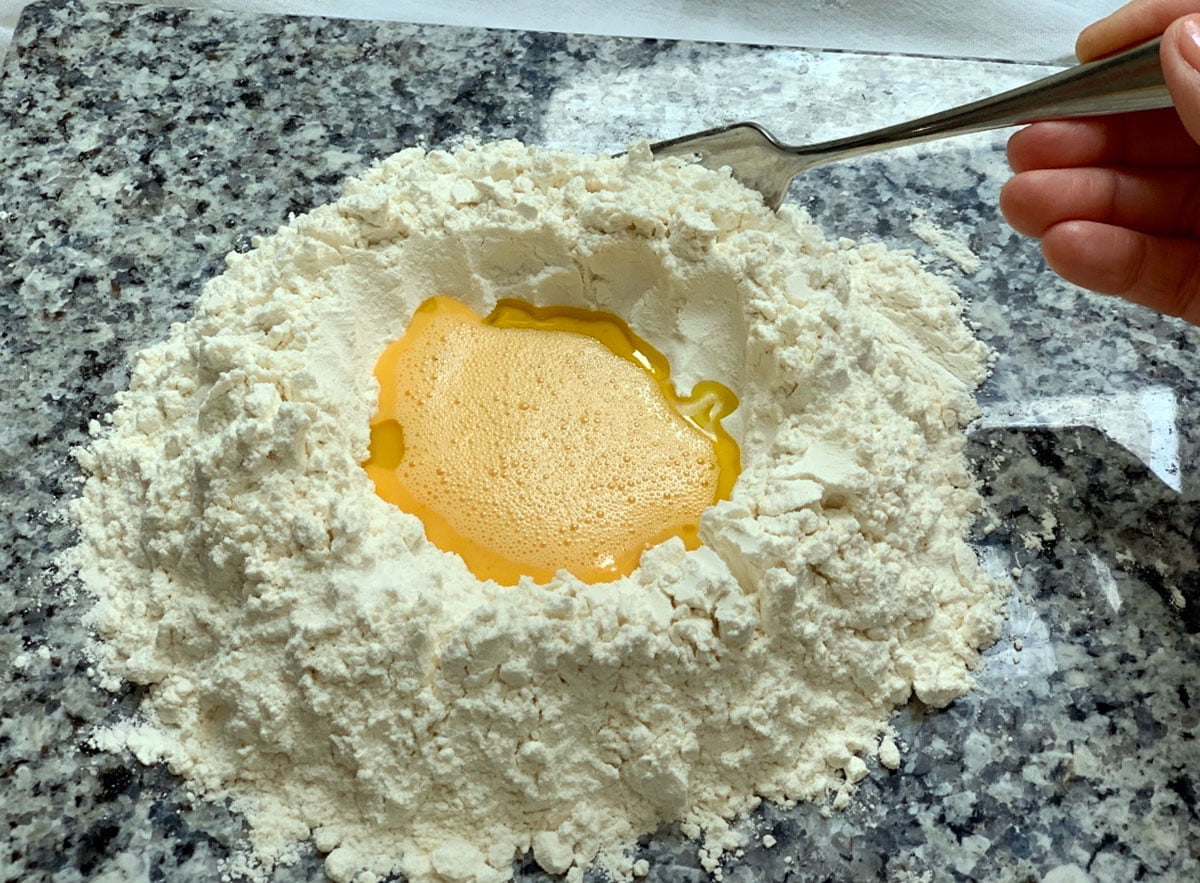
A Simple Tool – Or Two – For Easier Pasta Making
The first tool that makes this egg enriched pasta dough come together quickly, is a food processor.
In less than 5-minutes the flour and eggs become a soft-crumble, deep yellow, rich mixture.
Turning the mixture out onto a lightly floured surface to press into a disc, wrap and rest for a bit, is also fast and easy.
My most favorite tool now, is the pasta roller attachment that pops into my electric mixer because it not only rolls the pasta into the thickness I want quickly, but it is also great for rolling out crackers and flatbread.
There is also another version that works quite well, and it simply clamps onto the edge of a countertop.
Simple tools make time-consuming, yet wholesome food, so much easier to accomplish in half the time.

Do You Have A Favorite Pasta Shape?
Taking the easy way out, the first time I made pasta, I simply cut long thin strips of my thinly rolled pasta sheets, into Long Spaghetti shapes. But I was sure there were far more unique shapes I could turn my pasta into.
By the second time of working with pasta dough, I was ready for a fun new shape, known as Garganelli. Garganelli resembles a penne pasta or rigatoni shape, in that they are formed into a tubular pasta.
But how was I going to make tubular shaped pasta by hand? I knew there had to be either a fancy tool or an old fashioned tool Nonna’s (Italian grandmothers), have been using for centuries.
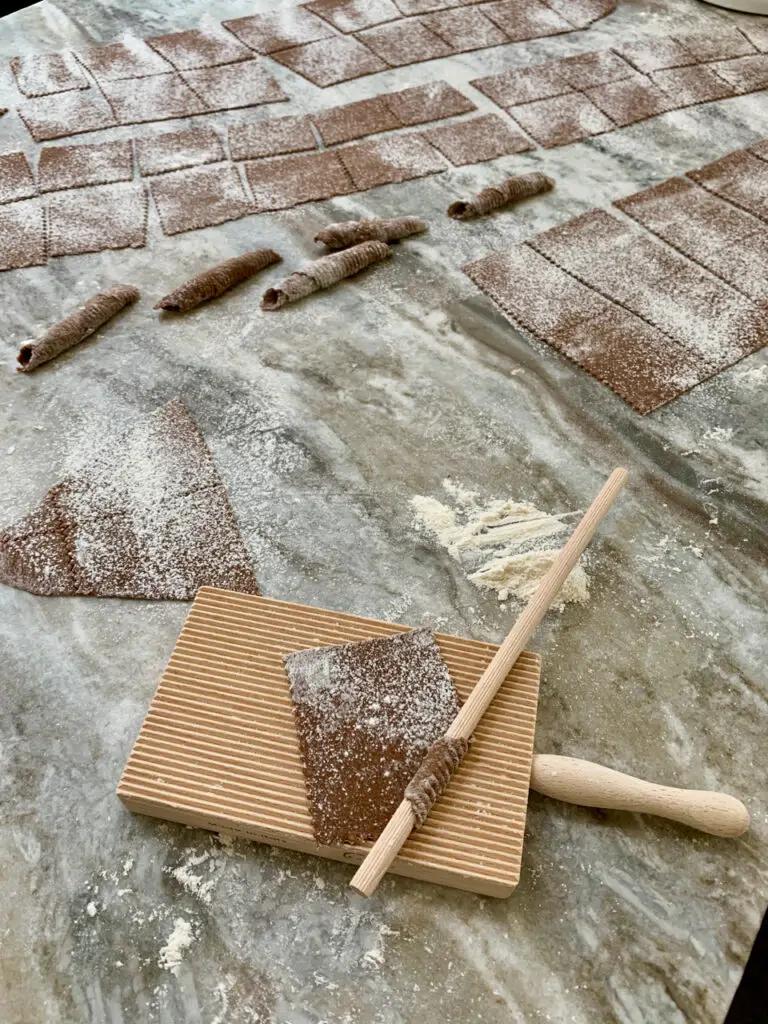
The Beauty Of A Traditional Garganelli Tool
Who knew there was such a fabulous tool for making pasta with a ridged surface, using a wooden board!
If you love gnocchi, then you already know this as a gnocchi board. It is a very affordable wooden board with close ridges, and a wooden dowel, also with thin ridges.
Once you have prepared the squares of fresh egg pasta dough, the fun part begins, simply rolling, pressing lightly and sliding off.
The best way to shape traditional garganelli is by rolling a small square of dough, cut into a diamond shape, across the board with the little wooden dowel. It quickly becomes a tube shaped pasta with ridges.
The best part about the ridges is that sauce clings to the pasta beautifully, as well as offering a unique texture to a simply piece of pasta.
How To Make Homemade Garganelli Pasta Without A Special Tool
Should you be less concerned about ridges, but more in favor of a tubular shape, we can make smooth garganelli too.
Simply cut 2-inch squares of thin pasta dough, and with a little wooden stick or wooden spoon handle on a flat surface, simple roll the little squares into a small tube shape.
For an added measure of texture to the smooth garganelli, you can cut the little squares with a pasta wheel, which gives the edges a pretty scalloped edge. This is a tool I also use to cut edges on my Pie Crusts.
For both techniques, you can watch the little video I placed in the recipe card below and you will see my grandsons using both techniques.
Pasta Flour
Did you know that’s a thing? Yep, apparently the finer the grind of the wheat into flour, the smoother the pasta will turn out.
Bread flour or baking flour will work just fine but ’00’ flour is the best for a smooth pasta. Semolina is also a flour used most often in pasta making.
It is a flour made from durum wheat and is much higher in gluten than regular flour, which, ‘sorry gluten-free folks’ but gluten really helps the pasta to hold it’s shape.
Favorite Pasta Sauces For Homemade Garganelli Pasta
Let’s be honest about pasta sauces, there is no limit to the possibilities!
Speaking as a grandmother, I can count on my grandkids loving a Bolognese Sauce with grated cheese on top.
However, us grownups sometimes like anything from a very tasty cheese sauce, simple cream sauces with a an aged parmesan cheese, to an elaborate
very Italian Sage Chestnut Sauce.
As for me, throughout the summer months, I simply love a Pesto Sauce made from homegrown herbs and veggies:
- Pea Pesto – fresh garden peas, with garden mint made into a refreshing pesto, perfect with seafood.
- Almond Basil Pesto – sweet almonds, aromatic basil and lots of garlic for a perfect pasta pesto.
- Spinach Walnut Pesto – a substantial pesto with iron rich spinach and omega packed walnuts.
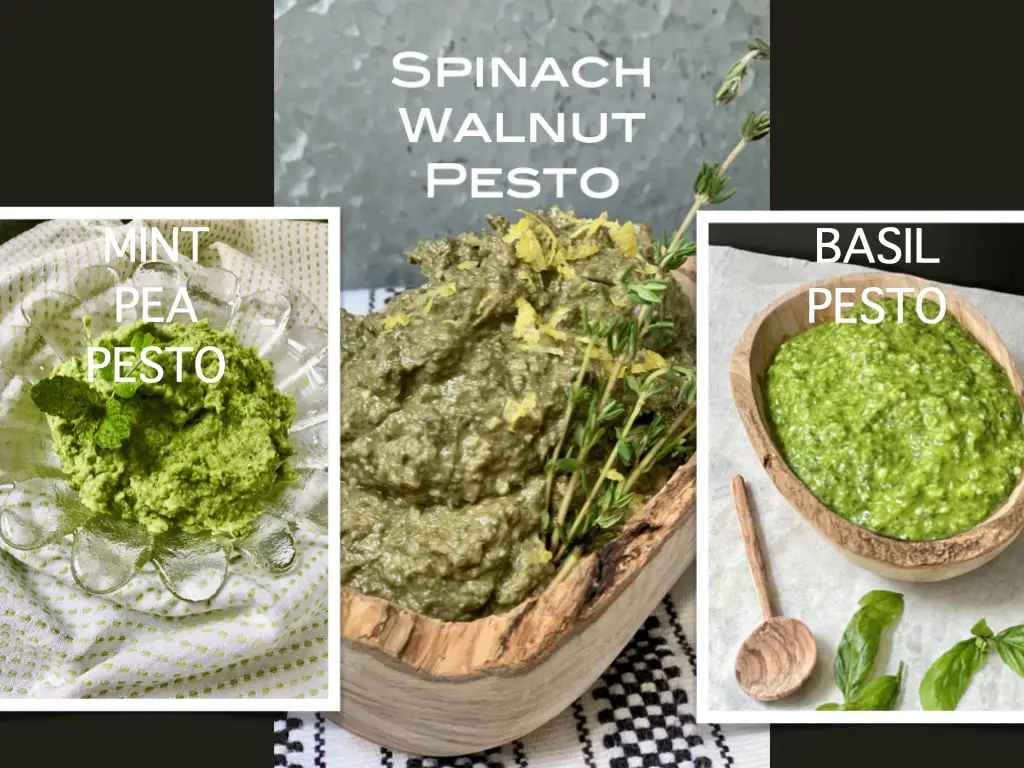
Imagine Chocolate Chili Garganelli!
Once you feel confident in making your own pasta, you simply must venture out and try making my Chocolate Chili Pasta!

Chocolate Chili Pasta is a spicy savory pasta, and once it’s rolled out, it too can be shaped into garganelli pasta!

Garganelli Board or Gnocchi Board
Garganelli Board or Gnocchi Board is an 8 inch by 3 inch wooden board, often with a handle, and has ridges in the board to imprint ridges into the dough.
It creates these lovely grooves in the dough so the sauce has some place to hide. A perfectly agreeable board can cost as little as five dollars or as much as forty. An affordable tool to add to your kitchen!

Ingredients Needed
It’s amazing how just three humble ingredients can create something so delicious. Each one plays an important role in giving Garganelli its silky texture, golden color, and perfect bite.
- Flour – The foundation of the dough. All-purpose flour keeps the texture soft and tender, while “00” flour (if you have it) creates an even silkier, more elastic dough that’s easy to roll thin. It gives the pasta strength without toughness, so it holds its shape beautifully when rolled into ridged tubes.
- Eggs – The heart of fresh pasta. They add richness, color, and flavor, giving Garganelli that sunny yellow hue and tender, springy bite. The natural fats in the yolks create a dough that’s smooth to handle and luxurious on the palate.
- Salt – A tiny but mighty touch. Just a pinch enhances the flavor of the dough and helps bring out the sweetness of the flour and the depth of the egg. Think of it as the quiet seasoning that ties everything together.
Equipment Needed
With just these simple tools, you can go from dough to dinner with minimal fuss, but maximum satisfaction. There’s something so joyful about rolling each piece, seeing the ridges form, and knowing it will taste far better than anything store-bought.
- Garganelli board – This small ridged board, traditionally made in Italy, is the star of the show. Its grooves create the signature ridges that help sauces cling, while also guiding the dough into perfect quill shapes. It’s easy to use, and once you roll the pasta over it, you’ll feel like a true Italian artisan.
- Boiling pot – Fresh pasta cooks quickly, and a large pot of boiling water gives the Garganelli room to float freely without sticking together.
- Measuring cup and measuring spoons – Precision matters, even with simple pasta. Measuring ensures the right ratio of eggs to flour, and a pinch of salt, the difference between dough that’s silky and dough that’s tough.
- Slotted spoon – When the Garganelli are cooked to al dente perfection, a slotted spoon makes lifting them from the pot easy, so they don’t break and you can transfer them straight to your sauce.

Homemade Garganelli Pasta
Equipment
- Garganelli rigid board and dowel
- Boiling pot
- Pasta roller, if possible
Ingredients
Pasta Ingredients
- 2 Whole eggs
- 4 Egg yolks save the whites for Macarons
- 1 tsp Salt more for boiling water
- 2 cups Flour more for dusting
Instructions
- Placing all of the ingredients into a food processor, pulse the ingredients until it becomes a small granular looking mixture. When the mixture is squeezed between two fingers, it sticks together. If it doesn't, simply scrape down the sides, loosen the mixture with a fork, and run the machine again. It takes just a few minutes and turns the dough into a deep rich yellow color.
- Transfer the dough mixture to a lightly floured board or flat work surface. Squeeze the dough into a dough ball. Then with the heel of your palm, press the dough into a disc. Wrap in plastic wrap, and allow to sit out on the counter for 30-minutes to rest.
- Unwrap, and roll out the dough into a long strip. Try to get it to about quarter of an inch. The thinner the better however the pasta roller will do the rest of the work.
- With the pasta roller set on the largest opening, roll the dough through. Change the pasta roller setting down one, and roll through again. Change it again to a smaller opening, and roll the dough through until you have a long thin strip of dough.
- With a knife, pizza cutter or pastry cutter, cut the dough into 2-inch squares. Place the pasta square onto the garganelli board and with the small wooden dowel or handle of a wooden spoon, roll the square into a cylinder shape, and slide off from the stick. Do the same with all the pasta squares.
- Leave the pasta to sit out on a sheet of parchment paper for a few hours to dry the pasta.
- When ready to cook, bring about 6 quarts of salted water to a bowl over medium heat. Place the dry pasta into the water and cook until it feels tender; 2-3 minutes if the garganelli is very thin, 7-8 minutes if it is thicker.
- Drain and serve with a sauce of your choice.
Video
